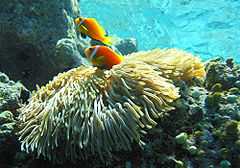Stichodactylidae
| Stichodactylidae | |
|---|---|
 | |
| Heteractis magnifica with Maldive anemonefish and juvenile Threespot dascyllus. | |
| Scientific classification | |
| Kingdom: | Animalia |
| Phylum: | Cnidaria |
| Class: | Anthozoa |
| Subclass: | Hexacorallia |
| Order: | Actiniaria |
| Family: | Stichodactylidae Andres, 1883 |
| Genera | |
| |
Stichodactylidae is a family sea anemones that contains the genera Stichodactyla (carpet anemones) and Heteractis. These sea anemones are exclusively tropical and are in the main family of sea anemones that hosts several varieties of clownfishes.[1] Most sea anemone species are harmless to humans, but at least some Stichodactyla are highly venomous and their sting may cause anaphylactic shock and organ failure (notably acute liver failure).[2][3] In contrast, the venom of Heteractis has shown potential in treatment of lung cancer.[4]
- Genus: Heteractis
- Heteractis aurora
- Heteractis crispa
- Heteractis magnifica
- Heteractis malu
- Genus: Stichodactyla (carpet anemones)
- Stichodactyla duerdeni
- Stichodactyla gigantea
- Stichodactyla haddoni
- Stichodactyla helianthus
- Stichodactyla mertensii
- Stichodactyla tapetum
Gallery
-

Stichodactyla tapetum
-

Heteractis aurora
References
- ↑ Fautin, D.G.; Allen, G. R. (1994). Anemone fishes and their host sea anemones. MN: Voyageur Press.
- ↑ Garcia, P.J.; Schein, R.M.; and Burnett, J.W. (1994). Fulminant hepatic failure from a sea anemone sting. Ann. Intern. Med. 120: 665–666.
- ↑ Nagata, K.; Hide, M.; Tanaka, T.; Ishii, K.; Izawa, M.; Sairenji, T.; Tomita, K.; and Shimizu, E. (2006). Anaphylactic shock caused by exposure to sea anemones. Allergol. Int. 55: 181–184.
- ↑ Ramezanpour, M.; da Silva, K.B.; and Sanderson, B.J. (2014). Venom present in sea anemone (Heteractis magnifica) induces apoptosis in non-small-cell lung cancer A549 cells through activation of mitochondria-mediated pathway. Biotechnol Lett. 36(3): 489-495.